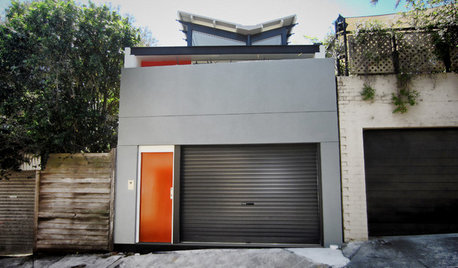Zoysia lawn can't get enough water
johnb352
12 years ago
Related Stories

LANDSCAPE DESIGNGet Along With Less Lawn — Ideas to Save Water and Effort
Ditch the mower and lower your water bill while creating a feast for the eyes with diverse plantings and gathering places
Full Story
CONTEMPORARY HOMESHouzz Tour: Strong Enough for Storms, Comfy Enough for a Family
Hurricanes won’t faze this contemporary waterfront home in North Carolina — and mixed reactions don’t faze its owner
Full Story
SAVING WATERXeriscape Gardens: How to Get a Beautiful Landscape With Less Water
Conserve water and make gardening much easier with the xeriscape approach’s 7 principles
Full Story
MOST POPULARA Fine Mess: How to Have a Clean-Enough Home Over Summer Break
Don't have an 'I'd rather be cleaning' bumper sticker? To keep your home bearably tidy when the kids are around more, try these strategies
Full Story
PETS5 Finishes Pets and Kids Can’t Destroy — and 5 to Avoid
Save your sanity and your decorating budget by choosing materials and surfaces that can stand up to abuse
Full Story
LANDSCAPE DESIGN7 Low-Maintenance Lawn Alternatives
Turf isn't the only ground cover in town. Get a lush no-grass lawn with clover, moss and other easy-care plants
Full Story
ARCHITECTUREHouzz Tour: Sturdy Enough for a Tsunami
Storms don't scare this Washington state home; breakaway features and waterproof finishes let it weather high winds and waves
Full Story
COLORGoing Bold With Just Enough Color
Using color with restraint inside and outside can be far more effective than a less subtle approach
Full Story
LANDSCAPE DESIGNCalifornia Says Goodbye to the Sprawling Ornamental Lawn
New state rules will effectively limit turfgrass to 25 percent of the landscape in most new and renovated yards
Full Story
MIDCENTURY HOMESHouzz Tour: How Can We Get Invited to This Awesome Midcentury Home?
A redwood-clad gem in California’s Marin County features a dreamy outdoor oasis with an open-door policy for the homeowners’ friends
Full StoryMore Discussions







tiemco
botanicalbill
Related Professionals
Arlington Landscape Architects & Landscape Designers · Ballenger Creek Landscape Architects & Landscape Designers · North New Hyde Park Landscape Architects & Landscape Designers · Rancho Cordova Landscape Architects & Landscape Designers · Severn Landscape Architects & Landscape Designers · Garden City Landscape Architects & Landscape Designers · Arlington Landscape Contractors · Bowie Landscape Contractors · Del Aire Landscape Contractors · Newnan Landscape Contractors · North Potomac Landscape Contractors · Shafter Landscape Contractors · Glenn Heights Swimming Pool Builders · Lisle Swimming Pool Builders · Rowlett Swimming Pool Buildersnearandwest
johnb352Original Author
nearandwest
botanicalbill
dchall_san_antonio
botanicalbill
nearandwest
johnb352Original Author
nearandwest
dchall_san_antonio
botanicalbill
lou_spicewood_tx
lou_spicewood_tx
johnb352Original Author
nearandwest
mrmumbels
nearandwest
botanicalbill
mrmumbels
botanicalbill
dchall_san_antonio
mrmumbels
dchall_san_antonio
k8zatnpfl